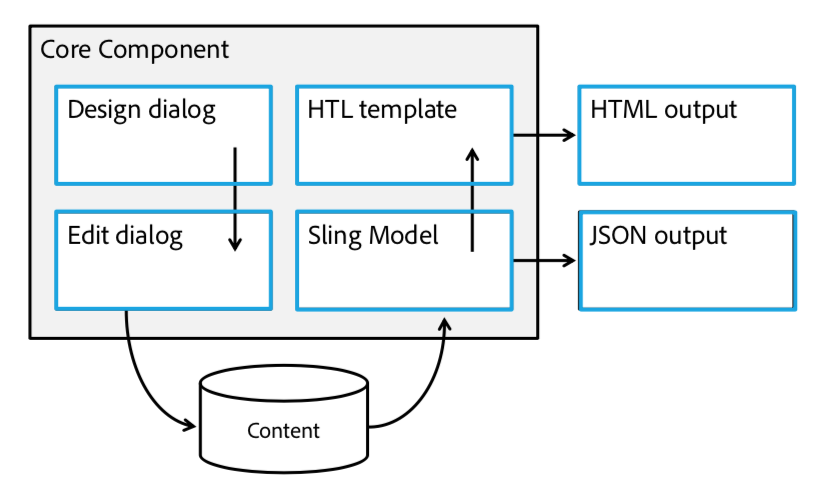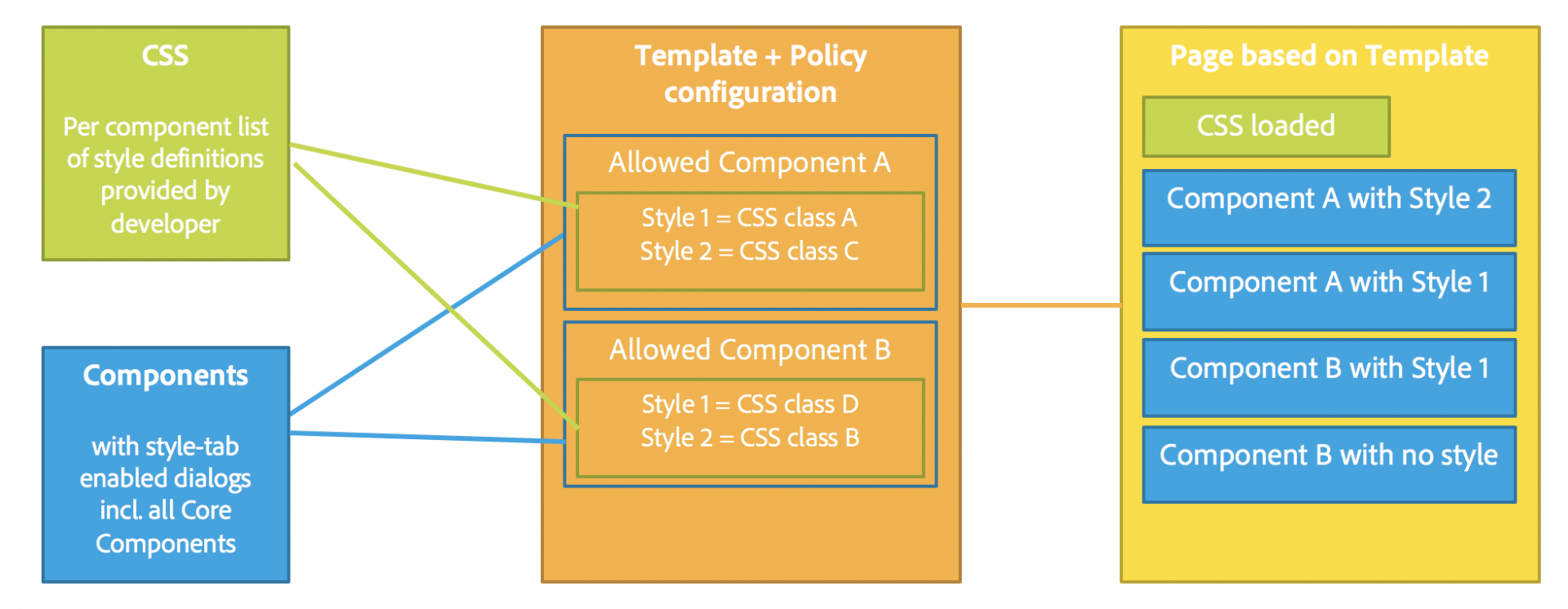Introduction
Adobe Experience Manager (AEM) Core Components are a fundamental part of the AEM ecosystem, providing a robust set of pre-built, modular components that enhance the authoring experience and accelerate development. These components are designed with a focus on reusability and consistent user interface (UI) and user experience (UX). In this article, we will explore the key concepts and benefits of AEM Core Components, and how they can revolutionize the way you build and manage content in AEM.

Component Library: Building Blocks for Rapid Development
The Component Library serves as a comprehensive collection of pre-built components available out-of-the-box in AEM. It offers a wide range of functionality, from simple text components to complex carousels and navigation menus. By leveraging the Component Library, developers can significantly reduce coding effort and rapidly build feature-rich websites.
Some noteworthy features of the Component Library include:
- Modular Design: The components are designed to be modular, allowing easy integration and customization within your AEM project.
- Customization Options: The Component Library provides extensive customization options, enabling you to tailor the components to match your specific project requirements.
- Consistency: All components in the library follow consistent design patterns, ensuring a cohesive and unified user experience across the entire website.
Component Structure: Organizing Content Hierarchically
AEM Core Components follow a hierarchical component structure, allowing you to organize your content in a logical and structured manner. This structure provides flexibility and scalability, empowering you to build complex content architectures.
Key aspects of the Component Structure:
- Hierarchical Organization: Components can be organized hierarchically, creating parent-child relationships that reflect the content structure.
- Component Inheritance: AEM Core Components support component inheritance, allowing you to define base components that can be extended and customized for specific use cases. This approach ensures consistency and reusability across your project.
By leveraging the Component Structure, you can create flexible content models that align with your business needs and enable efficient content management.

Content Fragments: Structured and Reusable Content Blocks
Content Fragments are a powerful feature of AEM Core Components, providing structured and reusable content blocks that can be used across multiple pages and channels. Content Fragments enable content consistency and simplify the process of managing and updating content.
Key benefits of Content Fragments:
- Structured Content: Content Fragments allow you to define structured content schemas, ensuring consistency and standardization of content across your website.
- Reusable Content Blocks: With Content Fragments, you can create content blocks that can be reused throughout your website, minimizing duplication and simplifying content updates.
- Multichannel Delivery: Content Fragments can be easily delivered to various channels, such as websites, mobile apps, and even IoT devices, ensuring a consistent message across all touchpoints.
Content Fragments streamline content creation and maintenance, empowering content authors and improving overall content governance.
Editable Templates: Empowering Content Authors
Editable Templates provide a powerful authoring experience within AEM Core Components. These templates enable content authors to create and customize pages using predefined components, without the need for extensive coding or technical expertise.
Key features of Editable Templates:
- Content Authoring: Editable Templates offer a user-friendly interface for content authors to create and edit pages. Authors can focus on content creation without worrying about the underlying technical complexities.
- Template Customization: Templates can be customized to fit specific project requirements, allowing you to define the structure and available components for each page.
- Streamlined Content Creation: Editable Templates streamline the content creation process, enabling authors to create pages efficiently and consistently across the entire website.
By leveraging Editable Templates, organizations can empower content authors to take full control of content creation, resulting in faster time-to-market and increased productivity.
Responsive Design: Consistent Experiences Across Devices
In today’s digital landscape, delivering consistent user experiences across devices is essential. AEM Core Components embrace responsive design principles, ensuring your content adapts seamlessly to different screen sizes and devices.
Key aspects of Responsive Design in AEM Core Components:
- Device-Agnostic: AEM Core Components are designed to be device-agnostic, meaning they can adapt and display content optimally on various devices, including desktops, tablets, and smartphones.
- Adaptive Layout: Components within AEM Core Components automatically adjust their layout based on the available screen space, providing an optimal viewing experience for users.
- Mobile-Friendly Content: With responsive design, your content becomes inherently mobile-friendly, enhancing usability and accessibility for users on the go.
By adopting responsive design principles with AEM Core Components, organizations can deliver consistent and engaging experiences to their audience, regardless of the device they are using.
Style System: Centralized Styling Control
Maintaining a consistent and cohesive visual identity across your website is crucial for brand recognition. The Style System in AEM Core Components allows you to manage and control the styling of your components, ensuring a unified look and feel.
Key features of the Style System:
- CSS-Based Styling: The Style System uses CSS to define the visual styles of components, providing a familiar and flexible approach for frontend developers.
- Branding Control: With the Style System, you can easily customize the styling of components to align with your brand guidelines, maintaining a consistent visual identity throughout your website.
- Global Style Management: The Style System offers centralized style management, allowing you to make global style changes that automatically reflect across all instances of the components.
By leveraging the Style System, organizations can establish a strong and cohesive visual presence, reinforcing brand identity and improving user engagement.

Content Policies: Ensuring Quality and Compliance
Maintaining content quality and adhering to brand standards are crucial for delivering a seamless user experience. AEM Core Components provide Content Policies, which enable rule-based content validation and governance.
Key aspects of Content Policies:
- Rule-Based Content Validation: Content Policies allow you to define rules and validation criteria to ensure the quality and consistency of content. These rules can cover aspects such as required fields, character limits, and content structure.
- Content Governance: By implementing Content Policies, you establish a framework for content governance, ensuring that authors follow standardized guidelines and adhere to compliance requirements.
- Quality Assurance: Content Policies act as a safety net, preventing the publication of content that does not meet the defined criteria, thus maintaining the integrity of your website.
Content Policies empower organizations to enforce content quality standards and streamline the content creation process, ultimately enhancing the user experience.
Client-Side Rendering (CSR): Performance and Interactivity
Client-Side Rendering (CSR) is a rendering approach offered by AEM Core Components that enhances performance and interactivity by rendering components on the client-side.
Key aspects of Client-Side Rendering:
- Browser-Based Rendering: With CSR, components are rendered on the client-side, leveraging the capabilities of modern web browsers. This approach reduces server-side rendering overhead and improves overall performance.
- Dynamic Content Loading: CSR enables dynamic content loading, where components fetch data asynchronously, providing a smoother and more interactive user experience.
- Improved Performance: By offloading rendering tasks to the client-side, CSR significantly improves page load times, resulting in faster and more responsive websites.
By leveraging Client-Side Rendering with AEM Core Components, organizations can deliver lightning-fast experiences and highly interactive websites to their users.
Accessibility: Inclusive User Experiences
Creating inclusive user experiences is a top priority for organizations today. AEM Core Components incorporate accessibility best practices, ensuring that your websites meet the highest standards of accessibility.
Key considerations for accessibility in AEM Core Components:
- WCAG Compliance: AEM Core Components are designed to adhere to the Web Content Accessibility Guidelines (WCAG), ensuring accessibility for users with disabilities.
- Assistive Technology Support: AEM Core Components are compatible with a wide range of assistive technologies, such as screen readers and keyboard navigation, providing an inclusive experience for all users.
- Reach Wider Audience: By prioritizing accessibility, organizations can reach a wider audience, including individuals with disabilities, and ensure equal access to information and services.
Creating accessible experiences with AEM Core Components not only aligns with ethical standards but also helps organizations comply with legal requirements and build a more inclusive digital presence.
Conclusion
AEM Core Components revolutionize the way organizations build and manage content in Adobe Experience Manager. With their core functionality, modular design, and focus on reusability, AEM Core Components enhance the authoring experience and accelerate development. By leveraging the Component Library, Component Structure, Content Fragments, Editable Templates, and other key features, organizations can deliver consistent, responsive, and accessible digital experiences.
Embracing AEM Core Components empowers organizations to streamline content creation, ensure brand consistency, improve performance, and provide inclusive user experiences. As you embark on your journey with AEM Core Components, explore the vast possibilities they offer and unlock the true potential of your digital experiences.

I’m Kirill Efimov, an experienced AEM developer with over 10 years of experience in Java and web development. I’m skilled in developing AEM components, templates, workflows, and integrations with other systems, and I’m passionate about delivering high-quality solutions to my clients.
I also believe in knowledge-sharing and staying up-to-date with the latest developments in the industry. Through blog posts, tutorials, and speaking engagements, I’m committed to contributing to the AEM community and helping others overcome the challenges they may face in their AEM projects.